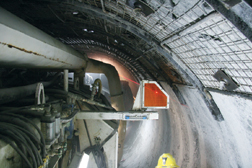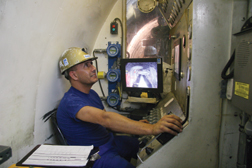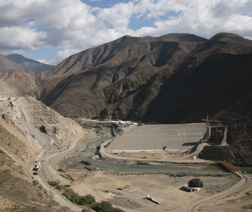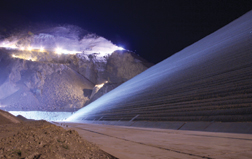... another three-week delay on the Atlantic side caused by heavy rains and flooding that cut power and washed out the access road, the TBM is still on schedule to complete the 14 km it is projected to dig by March 2009. It is advancing roughly 22 m per day. The other 6.2 kilometers were either dug previously or are to be excavated by drill-and-blast methods.
The machine is operated in two 12-hour shifts with a 4- to 6-hour downtime between shifts for maintenance and probe drilling.

Cliff Schexnayder / ENR
|

Cliff Schexnayder / ENR Operators use a laser target on the side of the TBM to stay on track. Air conditioners on the machine and in the tunnel bring temperatures to a tolerable 84ºF.
|
Playing It Safe
A stuck machine is a problem Odebrecht hopes to avoid, but there is a lack of geologic data because of the route’s depth, says production manager Winston Lewis. “We don’t use core drilling because the depth of the works are simply too extreme,” Lewis says. “The tunnel will be bored through hard rock that has good quality and it is stable, so we believe probe drilling is sufficient.”
Surveys suggest the TBM will mostly encounter quartz porphyry, andesite and tuff. There are more than 400 known faults along the the tunnel, but only two are considered major.
“There are not large fissures to contend with, but there is a pretty large number of microfissures,” Lewis said. While the fractures are a concern, they aren’t as critical as similar fissures might be in other places due to the local conditions, Lewis said. “When we do encounter a major fracture, it is much more stable because it is not holding much water,” he explained. “A dry fracture doesn’t have the same amount of pressure to threaten the TBM.”

Cliff Schexnayder / ENR
|

Cliff Schexnayder / ENR Roller-compacted-concrete Limón dam on Huancabamba River will impound 44 million cu m of water for diversion.
|
Lewis says crews are installing rock support behind the head to ensure the tunnel’s stability throughout construction, as well as the life of the project. The TBM is equipped to install rockbolts, ring beams and wire mesh to secure the cut as it progresses, as well as shotcrete segments for the floor of the tunnel.
The depth brings another problem though. Ambient air temperature in the tunnel is 130ºF, not a significant problem for the machine, but one for the workers. To bring the internal temperature down to 84ºF, the contractor has installed two cooling systems on the TBM and has two more stationary cooling systems inside the tunnel.
The number of units required is partly due to the altitude. The tunnel’s east entrance is 1,085 meters above sea level. The thinner air reduces the heat-transfer efficiency of the cooling equipment, making it necessary to use twice as many cooling units as would be required for the same job at lower elevations.
Post a comment to this article
Report Abusive Comment